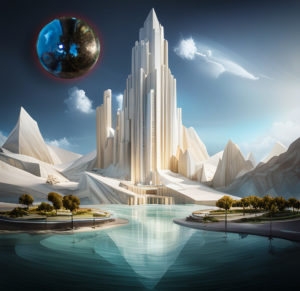 The Second Moon of Atlantis (Shared from Mu the Motherland)
The Second Moon of Atlantis (Shared from Mu the Motherland)
The recent release of the movie, ‘Oppenheimer’ has reopened discussions about nuclear energy as an instrument of war and as an energy source. As co-creators of ‘Mu the Motherland’ Blake and I live downwind from Los Alamos in southern New Mexico. In eastern New Mexico spent nuclear fuel storage sites are being expanded to store hot and highly radioactive uranium pellets inside metal rods. This waste can only be managed by machines and people have to be physically shielded from it, usually by steel or concrete. There are legal challenges in the courts, yet it seems like Los Alamos is once again busy developing nuclear power for both peaceful use and war. Is this the best we can do? Or are we setting humankind up for a tragic fall?
Our current earth changes are eerily reminiscent of those that existed before Atlantis collapsed and the circumstances that led to global catastrophe are similar. Instead of nuclear power, however, Atlantis’ scientists developed a clean energy source in the form of a massive, clear, and luminescent crystal—a technological marvel, harnessing the natural energies of the earth, the sun, and even the cosmos. It powered the entire continent, providing energy for transportation, healing, communication, and other advanced technologies that made Atlantis a beacon of civilization in the ancient world. The moniker “Second Moon of Atlantis” is symbolic, suggesting the crystal’s immense importance to the Atlanteans. Just as the moon influences the tides and rhythms of Earth, the Great Crystal was believed to influence the energies and life of Atlantis. Its luminescence was said to be so bright that it could be seen from distant lands, serving as both a beacon and a warning of Atlantis’s might.
Initially, the Atlanteans used the crystal’s energy for the betterment of their society. However, as time passed, factions within Atlantis began to misuse this power. Some theories suggest that they attempted to use the crystal as a weapon, directing its energy to subjugate neighboring lands or to wage wars—sound familiar?
Some theorists believe that the Atlanteans, in their quest for greater power and knowledge, began to experiment with the crystal, pushing its capabilities beyond safe limits. This reckless use disrupted the natural balance of energies on the continent and even on Earth itself. Many accounts converge on the idea that the misuse of the Great Crystal played a significant role in the continent’s downfall.
In the movie, Oppenheimer, the scene that depicts the first Trinity site test, also shows that there was concern that a chain reaction could occur and that earth’s atmosphere might catch on fire—blowing up the planet. Luckly, it didn’t; but it did pollute and contaminate the area and the developed bombs annihilated more than 200,000 Japanese, mostly civilians. (The casualty numbers increase as radiation induced medical conditions are calculated.) Nuclear war remains an ever-increasing threat today as nations position themselves to do battle.
In Atlantis, (although not of nuclear origin) the giant crystal also had the power to support or destroy humankind. The “Second Moon” of Atlantis floated in the skies supporting other crystal powerhouses that benefited life on earth in many ways. Scientific discoveries are neither good nor bad—but their use against humanity will, as they did in Atlantis, have catastrophic consequences. The exact cause of Atlantis’s destruction varies depending on the source. Some ancient texts suggest natural disasters—the earth rebelling against pollution, overcrowding and mid-managed resources. While others hint at self-inflicted catastrophe. I.e., someone (intentionally or not) pushed the wrong button. One theory suggests that the crystal, when overcharged or misdirected, created a massive energy discharge, leading to earthquakes, tsunamis, and volcanic eruptions. This chain reaction of natural disasters would have been enough to sink the entire continent, causing vast migrations to escape floods (remember Noah?) with many moving underground—later re-surfacing (as in the many emergence stories from around the globe) to begin again, in the most primitive ways.
Another theory suggests that the crystal created a rift in the fabric of space-time, leading to a dimensional shift that caused Atlantis to vanish from our reality. This idea is more esoteric but aligns with some beliefs that Atlantis was a bridge between dimensions. Whew!
No matter what you choose to believe, the story of the Great Crystal of Atlantis serves as a cautionary tale about the dangers of unchecked power and the responsibilities that come with advanced knowledge. Whether the crystal was real or a product of myth, its narrative underscores the delicate balance between progress and egotistical greed for fame and power.
The legend of Atlantis and its Great Crystal reminds us that civilizations, no matter how advanced, are vulnerable to both external threats and their own ambitions. As we continue to advance technologically and spiritually, the tale of the Second Moon of Atlantis serves as a poignant reminder of the need for wisdom, humility, and respect for the forces we harness.
Om Mani Padme Hum
Share
AUG
2023


About the Author:
Elaine Webster writes fiction, creative non-fiction, essays and poetry from her studio in Las Cruces, New Mexico—in the heart of the Land of Enchantment. “It’s easy to be creative surrounded by the beauty of Southern New Mexico. We have the best of everything—food, art, culture, music and sense of community.”